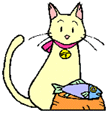Vol. 2, No. 12
Table of Contents
Feline Nutrition: Connecting the Dots
Assist Feeding: Bert’s Feeding Schedule
Kitty Potpourri: Breed Profile: The Ragdoll!
Best Cat Food: Flint River
Caring for Cats: Proactive Plan: Step-8
Feline Nutrition
Connecting The Dots
by Garry White
I read the most fascinating article this week, written by a DVM who was clearly (and passionately) very anti-commercial-foods; Doc was on a mission, so I won’t bother sharing the whole negative article with you. But whether intentional or not, the article provided some valuable information that goes hand-in-glove with our own persistent quest for good nutrition, and it pointed out our own disinclination to see the forest one tree at a time. Often, we just want the answer to something, and just as often it’s right there staring us in the eye.perhaps tucked inside another answer, but it’s there.
The article mentioned something that made me go back and do more study on the feline anatomy, specifically the eliminatory organs: Bowels, kidney, liver. Various toxins enter the digestive system, and the most prominent pathway is through ingestion.food. These organs (bowels, kidney, liver) fight to eliminate or excrete those toxins, which would, unattended, back up into the bloodstream, heart, and other organs that aren’t equipped to deal with them. Obviously, it’s a very complex and intricate system that amplifies our need to keep everything in balance.
Anyway, as I dug deeper, I discovered another organ, which plays an even bigger part in eliminating toxins than the kidneys, bowels, or liver! It wasn’t a blatant fact that stood out prominently, but there it was! Mind you, a first-year med student would know this, but I did not.or perhaps I did know it, but was too busy seeking complex answers, when the simple, obvious one was trying desperately to get my attention. So what is this mysterious organ that works harder than all the others to rid the body of toxins??
Skin! Trust me; it is the largest eliminative organ.
Ahh (slap the forehead), we knew that one, right? Maybe so and maybe not, but it doesn’t matter; we know it now, and we can use it to our benefit. How? Well, remembering that hair generally attaches to skin, our first observation that the body is trying to get rid of toxins would be in the appearance of their hair/fur. Hair follicles become laden with these toxins, and the coat will appear dull, lackluster, maybe clumpy looking, and may accumulate dander. Another indicator that toxins are pouring out of the skin is excessive shedding.
A focal skin dumping-station for toxins is the ears: Wax is a discharge, and excessive wax in the ears means simply that more toxins are being eliminated.by the skin!
Let’s summarize: Of course we know that a poor-looking coat can mean any number of things, but we also know this: Toxins are generally ingested with food, and we now know that the skin is the largest eliminative organ to rid the body of toxins. So, looking at it in reverse.unkempt fur, shedding (or excess wax in the ears) means that we should, for starters, take a very serious look at the diet. It’s amazing how all those little dots really do connect eventually, isn’t it?
Assist Feeding
Bert’s Feeding Schedule
by Kathy Fatheree
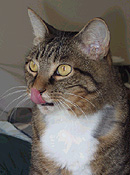 Last week… Bert got his nausea under control AND he was just being able to accept 106cc’s of food per feeding… up from 80cc’s!
Last week… Bert got his nausea under control AND he was just being able to accept 106cc’s of food per feeding… up from 80cc’s!
Bert’s Feeding Schedule
When we first brought Bert home, we were feeding him only 20cc’s at time. The clinic gave us syringes in progressively larger sizes for when we were able to increase feedings. He next went to 53cc and now we are all the way up to 106 cc’s per feeding!
NOTE: Most cats with FHL have stopped eating all together and their body is not used to having much food in the stomach. Feeding too much will just result in the kitty throwing it back up. Feeding too little will not cure the Feline Hepatic Lipidosis. The goal with FHL is to feed as much as the kitty can tolerate… it’s a fine line.
Bert’s Feeding Schedule
Changing Bert’s feeding to 3 times a day from 4 has been a great change for all of us! I think he tolerates the 3 feedings so much better and with a lot less stress. It’s not that he was OVERLY stressed with the fourth feeding, it’s just the less we mess with him the better. He gets fed at 6 a.m. every morning. This works out great for us because my husband gets up for work at 6 and so he just gets me up as well. Before Bert got sick, all three of the cats usually got up and were frisky at this time. Now that Bert is sick he doesn’t get up and move around a lot but I think that his internal clock is still set for that 6 a.m. time. He does really well with this feeding; he’s always relaxed and still kind of sleepy.
After my husband goes to work at 7:30, Bert and I go back to bed! 🙂 As soon as I turn the fan (we sleep with a fan 365 days a year, I think that’s what turned my kitties into burrowers!) Bert heads back under covers and snuggles with me.
NOTE: Good quality snuggle time helps with both the mental and physical healing process. This is so very important so please always make time to snuggle!
Bert’s second feedings is at 2 p.m. and honestly, he usually sleeps through the whole thing! He is so relaxed in the afternoons. He sleeps and watches the birds outside the windows.
NOTE: All of my cats have also slept really hard in the afternoons. If you are syringe feeding, feed before this sleepy-time. If tube feeding, take advantage of this drowsy time to sneak in a feeding.
Bert’s last feeding of the day is about 9:30 p.m. Mitch goes to bed at around 10 p.m. so I try to have Bert fed before then. That way they can both go to sleep without any interruptions. After I feed Bert, Mitch comes in and cuddles with him for a little while and then turns the fan on. As soon as the fan goes on Bert heads under covers to sleep between Mitch’s feet. They’ve been fighting for real estate on the bed lately! Bert is a bed HOG. He sleeps spread eagle and stretches his nails on Mitch’s legs when he feels cramped!! It’s hilarious to me to hear Mitch in there in the middle of the night telling Bert to move over!
We only aspirate Bert about one in four times now that he’s been on his 8 hour feeding schedule. He’s never aspirated higher than an 8 and 9 times out of 10 he’s only at 2 cc’s or 3 cc’s by the time he needs to be fed again. We’ve gotten pretty confident that he’s digesting normally and in plenty of time before his next meal. We check every few times though, just to make sure!
So overall I think Bert has adjusted to the 3 feedings a day wonderfully. He’s doing so great lately. I’m so glad to see how well he’s doing these last few days. He seems to be getting stronger every single day.
He goes in Friday for his official check up, I’ll be sure to update you as soon as we find out how he’s doing officially!
Kitty Potpourri
Breed Profile: The Ragdoll!
by Dan Malenski
We haven’t talked about any of the many feline breed for a while and decided that it is time, and this week, it’s the Ragdoll! The Ragdolls are huge, mellow cats with wonderful personalities that make excellent companions for those constantly not on the go. Their name stems from their tendency to relax all their muscles and go limp in one’s arms.
Unlike many cats, they like tummy rubs; thus, their going limp may be construed as a request for a good tummy rub!
Ragdolls are slow to mature and take 3-4 years to reach full maturity. Their coat doesn’t attain its full color until 2 years and full size is not reached until four years.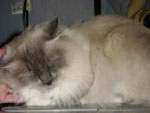 They are very large cats with females attaining a weight of 8-15 pounds and males often exceeding 20 pounds. Their eyes are large, oval shaped, and always blue along with large rounded ears with a forward tilt. Their coat is soft, medium long, and generally does not require a lot of maintenance. Their coat is often longer around their necks and on the back of their hindquarters and does not require a lot of maintenance. They are muscular cats with broad chests and long bushy tails.
They are very large cats with females attaining a weight of 8-15 pounds and males often exceeding 20 pounds. Their eyes are large, oval shaped, and always blue along with large rounded ears with a forward tilt. Their coat is soft, medium long, and generally does not require a lot of maintenance. Their coat is often longer around their necks and on the back of their hindquarters and does not require a lot of maintenance. They are muscular cats with broad chests and long bushy tails.
Ragdolls are pointed cats, like the Siamese, meaning that their faces, ears, legs, and tails are of a darker color than the rest of the body, although at birth, 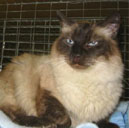 they are born white with their colors not showing until they are at least ten days old. They come in six colors: seal, blue, chocolate, lilac, red, and cream. Patterns are bi-color, van, mitted, and pointed. Amanda is giving me that puzzled look again, and I know that she remembers that “pointed” refers to the color of their face, ears, legs, paws, and tail from our discussion of the Siamese several months ago. She is able to figure out “bi-color”, but is having trouble with the van and mitted patterns. Cats with a “mitted” pattern have white gloves on their front legs and boots halfway up on their hind legs, with a white chest and chin. The vans are nearly all white and only their facemask, ears, and tail show darker markings.
they are born white with their colors not showing until they are at least ten days old. They come in six colors: seal, blue, chocolate, lilac, red, and cream. Patterns are bi-color, van, mitted, and pointed. Amanda is giving me that puzzled look again, and I know that she remembers that “pointed” refers to the color of their face, ears, legs, paws, and tail from our discussion of the Siamese several months ago. She is able to figure out “bi-color”, but is having trouble with the van and mitted patterns. Cats with a “mitted” pattern have white gloves on their front legs and boots halfway up on their hind legs, with a white chest and chin. The vans are nearly all white and only their facemask, ears, and tail show darker markings.
Ragdolls are generally easygoing cats that get along well with other animals and children and rarely use their claws when at play, although they are not particularly playful or active cats. They are people-oriented cats who bond well with their humans and will greet you at the door and follow you from room to room. They are nearly always underfoot; therefore, one needs to be particularly car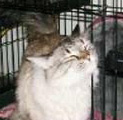 eful not to step on a nearby paw. Being that they always prefer to be close to their humans, they are always there to “help” with any household task-but what cat isn’t, certainly not Amanda or Melissa who have the knack of coming out of the woodwork whenever I am doing something!
eful not to step on a nearby paw. Being that they always prefer to be close to their humans, they are always there to “help” with any household task-but what cat isn’t, certainly not Amanda or Melissa who have the knack of coming out of the woodwork whenever I am doing something!
Unlike many other cats, however, Ragdolls do have some traits that you may wish to consider prior to adopting one. The Ragdoll is a quiet cat, meaning that it is generally not an active or playful cat, and is not particularly vocal. Unlike most cats, the 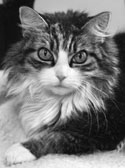 Ragdoll does not like to be left alone for long periods, and if your schedule keeps you out of the house for long intervals of time, you may wish to consider adopting another breed. Likewise, if you seek an outdoor cat because their trusting nature is a disadvantage outdoors. They have a difficult time determining between friend and foe.
Ragdoll does not like to be left alone for long periods, and if your schedule keeps you out of the house for long intervals of time, you may wish to consider adopting another breed. Likewise, if you seek an outdoor cat because their trusting nature is a disadvantage outdoors. They have a difficult time determining between friend and foe.
You will be able to find a selection of purebred Ragdoll and Ragdoll mixes in many of the shelters and rescue organizations around the nation, and we urge you to consider adopting one from these facilities first, if you feel that a Ragdoll matches your life style. All the pictures in this article are those of shelter cats seeking a home and someone to love. The last one with the captivating eyes is a brown Ragdoll/tabby mix.
Food of the Week
Flint River
by Garry White
Pffft! I was going to do Flint River foods this week based on research alone (I was unable to get a sample), but it seems the distributor who promised some input was too busy to bother with it. Corporate was wary to respond, for legal liability reasons, but assured me they might do so, with a 6-week advance notice. So I’ll say that I think the food is probably okay, and leave you with your own imagination as to how sincere this company is in dealing with their customers.
Anyway, instead of bragging about their food, I’ll take this opportunity to introduce you to my lab-rats.Er, I mean lab-cats; the guys who have fun testing all the new and exciting foods.Clarkie on the left, Wilbur on the right.
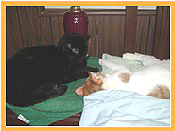
It’s noteworthy that this article serves to emphasize a point I’ve long believed in: It is, after all, okay to vary a kitty’s diet. There’s plenty of technical babble to support my philosophy, but as my vet says.The best test has four legs and a tail.
Caring for Cats
Proactive Plan: Step-8
by Garry White
Understanding blood-test reports
Most of us have no wish to become hematologists, but it’s frustrating when we haven’t a clue as to the very basics. The following list is not complete in defining every possible test function, nor should it be seen as a professional reference. Rather, it is compiled information covering most of the common test results we deal with in sick kitties, and is intended solely to give us at least a basic understanding of some of the medical terminology.
[ALB] 2.2-4.4
Albumin
The main protein in blood. Chemically, albumin is soluble in water, precipitated by acid, and coagulated by heat. Albumin and Globulin measure the amount and type of protein in your blood. They are a general index of overall health and nutrition. Globulin is the “antibody” protein important for fighting disease.
[ALT] 20-100
Alanine aminotransferase
An enzyme normally present in liver and heart cells that is released into the bloodstream when the liver or heart is damaged. The blood ALT levels are elevated with liver damage (for example, from viral hepatitis) or with an insult to the heart (for example, from a heart attack). Some medications can also raise ALT levels.
ALT is also called serum glutamic pyruvic transaminase (SGPT).
[AMY] 300-1100
Amylase
An enzyme produced in the pancreas and salivary glands that helps in the digestion of starches. Elevation of blood amylase is common in pancreatitis, and cats with CRF condition.
[BUN] 10-30
Blood Urea Nitrogen.
A measure primarily of the urea level in blood. (Urea: A nitrogen-containing substance normally cleared from the blood by the kidney into the urine. Urea is cleared by the kidney. Diseases that compromise the function of the kidney frequently lead to increased blood levels. A High BUN level (with low or normal creatnine) may indicate GI bleeding and bleeding ulcers. High BUN and high creatnine may indicate kidney failure.
[CA+] 8.0-11.8
Calcium
Is controlled in the blood by the parathyroid glands and the kidneys. Calcium is found mostly in bone and is important for proper blood clotting, nerve, and cell activity. An elevated calcium can be due to medications such as thiazide type diuretics, inherited disorders of calcium handling in the kidneys, or excess parathyroid gland activity or vitamin D. Low calcium can be due to certain metabolic disorders such as insufficient parathyroid hormone; or drugs like Fosamax or furosemide type diuretics. Calcium is bound to albumin in the blood, so a low albumin level will cause the total calcium level in the blood to drop. You doctor can easily determine if this is significant or not.
[CPK] 56-529
Is an enzyme which is very useful for diagnosing diseases of the heart and skeletal muscle. This enzyme is the first to be elevated after a heart attack (3 to 4 hours). If CPK is high in the absence of heart muscle injury, this is a strong indication of skeletal muscle disease.
[CRE] 0.3-2.1 Creatinine
Is a waste product largely from muscle breakdown. High values, especially with high BUN levels, may indicate problems with the kidneys..
[CRP]
C Reactive Proteins
This is a marker for inflammation. Traditionally it has been used to assess inflammation in response to infection. However we use a highly sensitive C Reactive Protein which is useful in predicting vascular disease, heart attack or stroke..
Author Note: This is a partial listing: Please print this and keep it inside the binder, for reference. The rest of the Blood Test Values will follow in coming weeks.
Disclaimer: Kathy Fatheree is not at all a medical expert. Contents of this web site are a collection of Kathy’s assist feeding experiences as well as the experiences of other cat owners who have assist fed their cats. While every effort has been made to ensure the accuracy of the information, Kathy Fatheree or anyone associated with this web site cannot be held responsible for anything that may happen as a result of using the information on this site.
